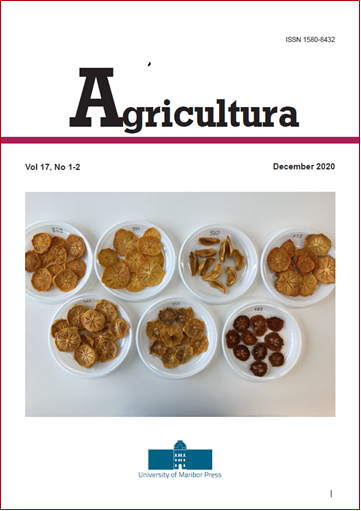Effect of Microcredit on Profit Efficiency of Small-Scale Poultry Farmers Oyo State, Nigeria
DOI:
https://doi.org/10.18690/agricultura.17.1-2.37-46.2020Keywords:
microcredit, profit efficiency, poultry, small scale farming, Oyo StateAbstract
This study investigated the effect of microcredit on profit efficiency of small-scale poultry farmers in Oyo State. Multistage sampling procedure was used to select two hundred poultry farmers for the study. Data collected were analysed using descriptive statistics, Heckman selection model, stochastic frontier and Tobit models. Result from descriptive statistics
showed that men (78%) are predominantly involved in poultry production. The average age of poultry farmers in the area of study is approximately 43 years. Most of the farmers are married (77.5%) and literate (80.5%). Furthermore, most of the respondents (73.5%) had access to microcredit with 87.5% belonging to one farmer’s association or the other. Heckman
two-stage selection model revealed that membership of cooperative/farmer’s association and contact with extension agent are the significant factors influencing farmer’s access to microcredit. The second stage of the model reveals that age, years of education, household size, years of farming experience, distance to source of microcredit, timeliness of microcredit and stock size are the significant factors influencing the amount of microcredit obtained by farmers. Results obtained from the stochastic frontier model showed that smallholder poultry farmers had an average profit efficiency of 54.0% in poultry production. Furthermore, the Tobit model (Model 1) results revealed that amount of microcredit, distance to source
of microcredit, interest rate and loan repayment period significantly influenced farmer’s profit efficiency while in the second model, years of formal education, poultry farming experience and membership of cooperative/farmer’s association influenced farmer’s profit efficiency. The results of two-side censored Tobit model suggest that microcredit variables are the most favourable variables for line of action. This suggested that policy makers should ensure that microcredit available through the agricultural credit programmes get to the needy farmers.
Downloads
Downloads
Published
Issue
Section
License
Copyright (c) 2021 Ronke Victoria Orimogunje, Ayodeji Sunday Ogunleye, Ayodeji Damilola Kehinde

This work is licensed under a Creative Commons Attribution-NonCommercial-NoDerivatives 4.0 International License.
